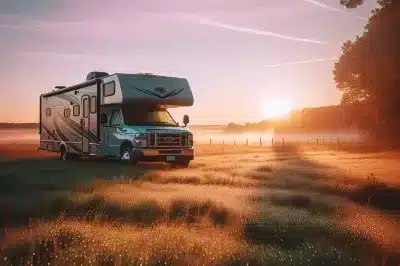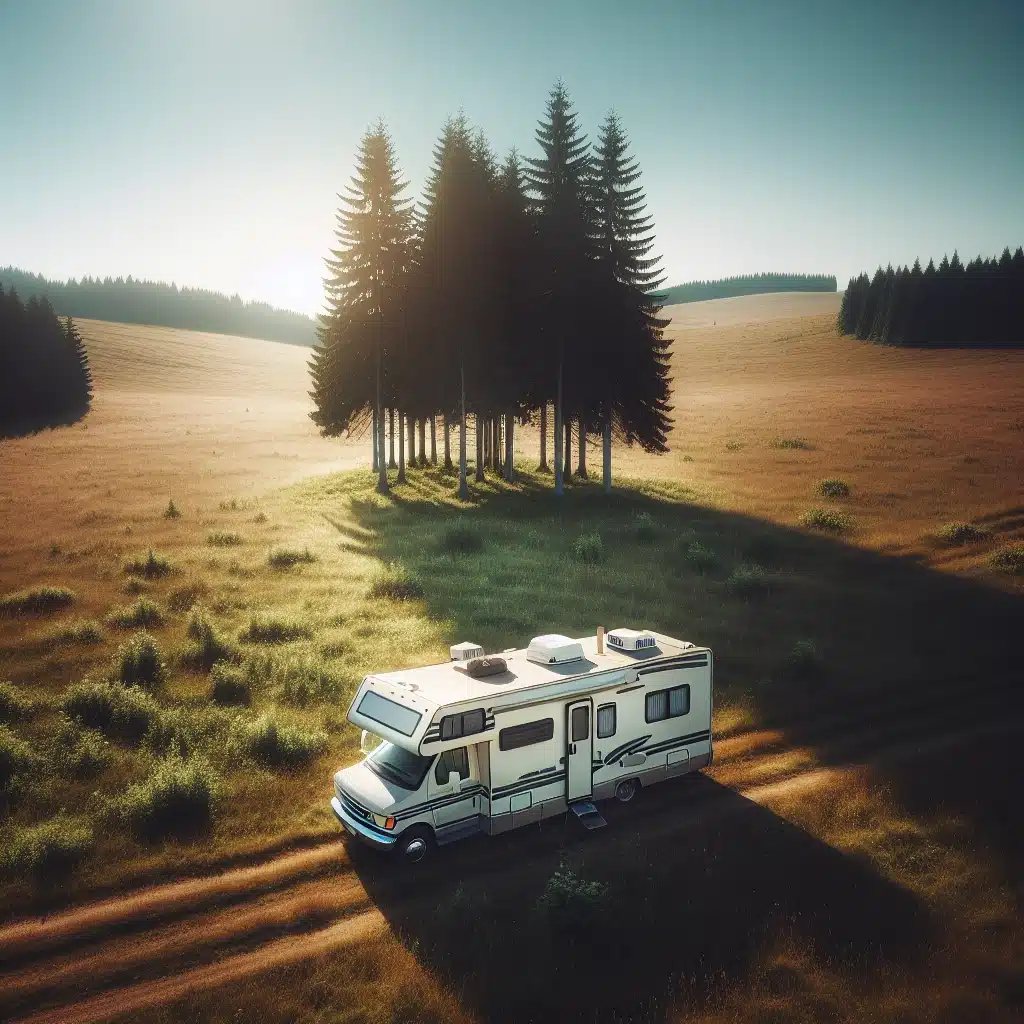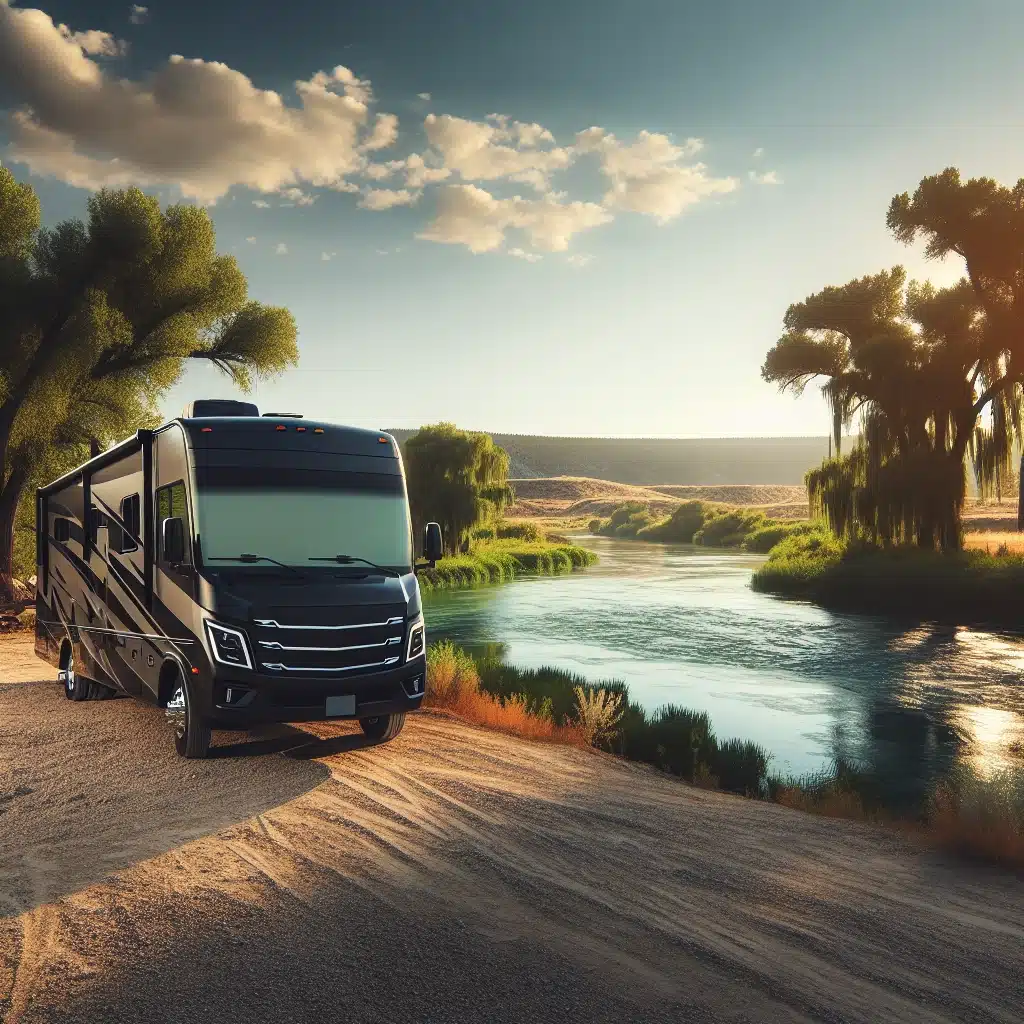Table of Contents

Your Essential Guide to a Solar-Powered Camp Setup
Imagine waking up to the gentle hum of nature, the morning sun casting a warm glow on your face. You step outside your RV into the crisp air, a fresh cup of coffee in hand, all thanks to the power of the sun. This is not just a dream; it’s a reality for those who’ve embraced solar-powered camp setups. In this guide, we’ll walk you through the ins and outs of using solar power to energize your RV adventures.
Why Solar is the Superior Choice for Camping
When it comes to camping, nothing beats the freedom of being self-sufficient. Solar power offers you the independence to camp off-grid, away from the constraints of fixed electrical hookups. It’s quiet, clean, and renewable, reducing your carbon footprint and allowing you to enjoy nature without the guilt of harming it. Plus, solar energy can save you money in the long run, cutting down on expensive campground fees.
Gathering the Sun: Equipment You Need
To harness the sun’s power, you’ll need a few key pieces of equipment. First, solar panels are the heart of your setup, absorbing sunlight and converting it into electricity. You’ll also need a charge controller to regulate the flow of energy to your batteries, preventing overcharging and damage. Batteries store this energy, ensuring you have power when the sun goes down. Lastly, an inverter will convert the stored DC power into AC power, usable for your everyday appliances.
- Solar Panels: The primary source of your power.
- Charge Controller: A vital tool to protect your batteries.
- Batteries: Where your solar power is stored for later use.
- Inverter: Converts DC power into appliance-friendly AC power.
- Mounting Hardware: To securely attach your panels to the RV.
- Cabling and Connectors: For efficient energy transfer.
- Monitoring System: To keep an eye on your energy production and usage.
Efficiently Harnessing the Sun’s Energy
Efficiency is key in a solar-powered setup. Start by calculating your energy needs to determine the size and number of solar panels you’ll require. Position your panels to capture the most sunlight — clear from shadows and angled correctly. Use high-quality cables and connectors to minimize energy loss. And remember, regular cleaning and maintenance of your panels will ensure they operate at peak performance.
Maximizing Your Solar Panels’ Performance
Getting the most out of your solar panels isn’t just about having the best equipment; it’s also about how you use it. Let’s talk about location and positioning, two critical factors that can make or break your solar experience.
Choosing the Optimal Location for Solar Panels
The right spot for your solar panels can significantly enhance their energy production. Aim for a location that receives direct sunlight for the majority of the day. Avoid placing panels under trees or in the shadow of other objects. The more sunlight your panels receive, the more power they’ll generate, ensuring your batteries stay charged and ready for use.
Remember, the sun’s path changes with the seasons, so adjust the placement of your panels as needed to capture the most light. And when you’re on the move, consider portable or adjustable panels that can be repositioned to follow the sun’s journey across the sky.
Here’s a simple checklist to help you find the perfect spot:
- Direct sunlight: Aim for maximum exposure to the sun’s rays.
- Minimal shading: Keep away from trees and other obstructions.
- Seasonal adjustments: Tweak the placement as the sun’s path shifts.
- Portable options: Consider panels that can move with the sun.
- Security: Ensure your setup is safe from theft or damage.
The Secret to Angle and Tilt in Solar Efficiency
The angle and tilt of your solar panels aren’t just about aesthetics; they’re crucial for maximizing energy absorption. The ideal angle is equal to your latitude, with adjustments made for the seasons. In summer, the angle should be less to capture the high sun, and in winter, increased to catch the lower sun. An adjustable mounting system can be a game-changer, allowing you to change the tilt throughout the year.
Here’s a quick guide to get you started: choosing the right high-capacity solar battery for your RV can make all the difference in your camping experience.
- Know your latitude: It’s the starting point for setting your angle.
- Seasonal adjustments: Tilt down in summer, up in winter.
- Use a solar angle calculator: For precision, there are tools available online.
- Consider the local climate: Snow and wind can affect the optimal tilt.
- Adjust regularly: A little effort can lead to significant gains in efficiency.
Monitoring and Maintenance for Peak Performance
Keeping an eye on your system’s performance is just as important as the initial setup. Use a monitoring system to track production and consumption. This not only helps you manage your energy use but also alerts you to any potential issues. Regular maintenance, including cleaning your panels and checking connections, ensures your system runs smoothly. Think of it as a health check-up for your solar setup.
Regular tasks should include:
- Cleaning panels: Dust and debris reduce efficiency.
- Checking connections: Loose wires can lead to power loss.
- Inspecting for damage: Weather can take a toll on your system.
- Updating software: For systems with digital monitoring, keep software current.

Power Storage: Batteries and Beyond
Storing the power your solar panels generate is essential for a consistent energy supply. Batteries are the backbone of your storage system, holding the energy for when the sun isn’t shining. But it’s not just about having a battery; it’s about having the right one for your needs, and knowing how to take care of it.
Selection of a Suitable Solar Battery
Choosing the right battery involves understanding your power needs. Deep cycle batteries are designed for the regular charging and discharging that solar systems require. There are several types, including lead-acid, lithium-ion, and AGM (absorbent glass mat), each with its own pros and cons. Consider capacity, lifespan, maintenance, and cost when making your decision.
Key considerations include:
- Capacity: How much energy the battery can store.
- Lifespan: How many charge cycles it can handle before it degrades.
- Maintenance: Some batteries require more upkeep than others.
- Cost: Higher upfront costs may lead to longer-term savings.
Battery Maintenance and Care
Maintaining your batteries is crucial for longevity and performance. Regularly check the voltage and specific gravity (for lead-acid batteries) to ensure they’re charging correctly. Keep them clean and free of corrosion, and ensure they’re stored at an appropriate temperature. Forgetting maintenance can lead to reduced capacity and even failure. For more detailed information on battery maintenance, visit RV Solar Power Pro’s breakdown of RV battery types.
Remember to:
- Check charge levels: Avoid overcharging or deep discharging.
- Keep them clean: Dirt and corrosion hamper performance.
- Store properly: Extreme temperatures can damage batteries.
- Stay safe: Work in a ventilated area and use protective gear.
Understanding Battery Capacity and Your Needs
Battery capacity is measured in amp-hours (Ah) and tells you how much energy you can store. To size your battery bank correctly, you’ll need to calculate your daily power usage and consider how many days of autonomy you want. This means how long your system can run without sunlight. It’s a balance between your energy needs and the practicality and cost of your battery system.
Consider these factors:
- Daily energy usage: Calculate the total power your appliances use.
- Days of autonomy: How long do you need your system to run without sun?
- Usable capacity: Batteries shouldn’t be fully discharged; factor in a buffer.
- Recharge time: Ensure your solar array can recharge the batteries efficiently.
Living Off-the-Grid: Managing Energy Consumption
Embracing the off-grid lifestyle means becoming a master of your energy consumption. It’s not just about generating power; it’s about using it wisely. Knowing what you use and when you use it can make all the difference in maintaining a sustainable and comfortable off-grid life.
Estimating Your Energy Needs
Before you can effectively manage your energy, you need to know how much you need. Start by listing all your electronic devices and appliances. Check their wattage and estimate how many hours a day you use each one. Multiply the wattage by the hours of use, and you’ll get a daily watt-hour figure for each item. Add them all up, and you’ve got a ballpark figure of your daily energy needs. This will guide you in sizing your solar system and battery bank appropriately.
Smart Appliance and Device Usage
Smart use of appliances and devices can significantly reduce your energy consumption. Opt for energy-efficient gadgets that do more with less power. Use LED lights instead of traditional bulbs, and when possible, use manual tools over electric ones. Charge devices during the day when solar energy is abundant, and consider using timers or multi-socket switches to avoid leaving things on standby.
- Energy-efficient appliances: They’re designed to do more with less.
- LED lighting: Consumes a fraction of the power of traditional bulbs.
- Manual tools: Sometimes the old ways are the best ways.
- Daytime charging: Make the most of the sun’s peak hours.
- Timers and switches: Cut power to devices when not in use.
Energy Conservation Tips and Tricks
Conserving energy is just as important as generating it. Insulate your RV to maintain temperature and reduce heating and cooling needs. Cook with a solar oven or use a pressure cooker to minimize energy use. Unplug chargers when not in use, and consider using a solar fridge that’s specifically designed to be energy-efficient. Every little bit helps in extending the life of your batteries and reducing the need for generator use.
- Insulation: Keep the inside temperature stable.
- Solar cooking: Use the sun’s heat to prepare your meals.
- Pressure cooking: Cook faster and use less power.
- Unplug chargers: They draw power even when not connected to devices.
- Solar refrigeration: Efficient cooling without the drain.

Be Prepared: Backup and Safety
Even with the best solar setup, it’s wise to prepare for those days when the sun plays hide and seek. Having a backup plan ensures you’re never left in the dark. Safety is also paramount when dealing with electricity, so proper precautions and equipment are non-negotiable.
When the Sun Doesn’t Shine: Backup Power Solutions
For those cloudy days or unexpected challenges, having a backup power source is essential. Generators can provide a quick and reliable power boost when needed. Alternatively, consider a secondary battery bank or a portable power station that can be recharged at home or on the go. It’s also smart to scale your solar system to have extra capacity for those less sunny periods.
- Generators: For immediate, on-demand power.
- Extra battery bank: A secondary source to tap into when needed.
- Portable power station: Rechargeable and convenient for emergencies.
- Scaled solar system: Build in a buffer to your energy production.
By following these steps and considering your backup options, you’ll be well on your way to enjoying a comfortable, sustainable, and secure off-grid life with solar power. Stay tuned for more tips and tricks to make the most of your solar-powered camp setup.
Ensuring Safety with a Solar Setup
Safety should never be an afterthought when dealing with electricity, even from the sun. Proper installation of your solar power system is crucial to prevent electrical hazards. Use appropriate fuses and breakers to protect against overloads. Ensure all components are rated for outdoor use and exposure to the elements. Regularly inspect your system for damaged wires or loose connections, and always follow the manufacturer’s guidelines.
- Proper installation: Follow guidelines to reduce the risk of hazards.
- Use of fuses and breakers: Essential for preventing electrical overloads.
- Outdoor-rated components: Designed to withstand the elements.
- Regular inspections: Catch and fix any potential issues early.
- Manufacturer’s guidelines: The roadmap to a safe and efficient setup.
Eco-Friendly Camping with Solar Power
Camping with solar power isn’t just about convenience; it’s a commitment to preserving the great outdoors. By choosing solar, you’re reducing reliance on fossil fuels and minimizing your ecological footprint. It’s a clean, silent, and sustainable way to enjoy your travels without leaving a mark on the environment.
The Environmental Benefits of Solar Camping
Using solar power for camping has a positive impact on the environment. It reduces emissions since you’re not burning fuel to generate electricity. Solar power also minimizes noise pollution, allowing both you and wildlife to enjoy the tranquility of nature. And because it’s renewable, you’re tapping into an energy source that’s as abundant as the daylight.
- Reduced emissions: Lower your carbon footprint.
- Noise pollution: Enjoy the sounds of nature, not generators.
- Renewable energy: Harness the limitless power of the sun.
Leave No Trace: Sustainable Camping Practices
Adopting a ‘Leave No Trace’ philosophy ensures that the natural beauty you enjoy today can be preserved for others tomorrow. Use biodegradable products, dispose of waste properly, and minimize your use of non-renewable resources. Solar power aligns perfectly with this ethos, allowing you to power your campsite without depleting or damaging the environment.
- Biodegradable products: Reduce your impact on the ecosystem.
- Proper waste disposal: Keep campsites clean and unpolluted.
- Minimize resource use: Conserve the environment for future generations.

Article-at-a-Glance: Key Takeaways
Here’s a quick recap of the most important points for setting up a solar-powered camp:
- Solar power offers freedom and self-sufficiency for off-grid camping.
- Essential solar gear includes panels, charge controllers, batteries, and inverters.
- Maximize panel performance by choosing the right location and adjusting the tilt angle.
- Battery selection and maintenance are crucial for a reliable power supply.
- Smart energy usage and conservation are key to sustainable living off-the-grid.
- Safety is paramount—ensure proper installation and regular system checks.
- Solar camping is eco-friendly, reducing emissions and noise pollution.
- Embrace ‘Leave No Trace’ practices to preserve the environment.
FAQ: Powering Up Your Campsite the Solar Way
Got questions about solar-powered camping? Here are some answers to help you get started:
How long will my solar batteries last?
The lifespan of your batteries will depend on the type, quality, and how well you maintain them. With proper care, most deep cycle batteries can last several years.
Embracing solar power for your camping adventures is a step towards sustainable living and uninterrupted off-grid experiences. With the right setup and maintenance, you can enjoy the comforts of home while being kind to the environment. Soak up the sun, and let it power your next adventure!
How do I maintain my solar batteries while on a camping trip?
Maintaining your solar batteries involves regular checks and upkeep. Monitor the charge level to prevent overcharging or deep discharging. Keep the terminals clean and tight to ensure efficient power transfer. If you’re using lead-acid batteries, check the water level and refill with distilled water as needed. Store the batteries in a cool, dry place to extend their lifespan and ensure they’re charged before storing for extended periods.
– Regularly check battery charge levels.
– Clean and tighten terminals.
– For lead-acid batteries, maintain the water level with distilled water.
– Store batteries in a cool, dry place.
What’s the best way to position my solar panels when camping?
The best position for solar panels is where they will receive maximum sunlight exposure throughout the day. This usually means facing them true south in the Northern Hemisphere or true north in the Southern Hemisphere. Tilt them according to your latitude and the season, and adjust them throughout the day if possible. Avoid shading from trees or other structures, as this can significantly reduce their effectiveness.
– Face panels towards the equator (south in the Northern Hemisphere, north in the Southern Hemisphere).
– Adjust the tilt angle based on your latitude and the season.
– Reposition panels throughout the day if possible for maximum exposure.
– Keep panels clear of any shade.
Can I run a refrigerator on my solar-powered camp setup?
Yes, you can run a refrigerator on a solar-powered camp setup, but it requires careful planning. Fridges are energy-intensive, so opt for an energy-efficient model designed for RV or off-grid use. Calculate the fridge’s daily energy usage and ensure your solar panel system can generate that amount. You’ll also need a battery bank with enough capacity to keep the fridge running when the sun isn’t shining, especially overnight.
Example: A 12V fridge that uses 2 amp-hours per hour needs 48 amp-hours per day. Your battery bank should be able to supply this without dropping below 50% capacity to maintain battery health.
How do I choose the right solar panel size for my camping needs?
To select the right solar panel size, consider the devices and appliances you’ll use. Calculate the total wattage they’ll consume in a day and add about 25% to that number to account for energy loss in the system and potential cloudy days. Then, look at the wattage rating of solar panels and choose a combination that meets or exceeds your daily watt-hour requirement. It’s better to err on the side of excess capacity than to fall short, especially when off-grid.
– List all devices and their wattage.
– Calculate daily energy consumption.
– Add a buffer for loss and unforeseen weather.
– Choose panels with a combined wattage that meets your needs.
Embrace the solar-powered journey and let the adventure begin!
- Boondocking RVs: Flexible Solar Solutions – 3 March 2024
- Renewable Energy Tips for Full-Time Boondocking RVers – 2 March 2024
- Boondocking Solar Power Systems: Sizing Options & Solutions for Motorhomes – 1 March 2024
